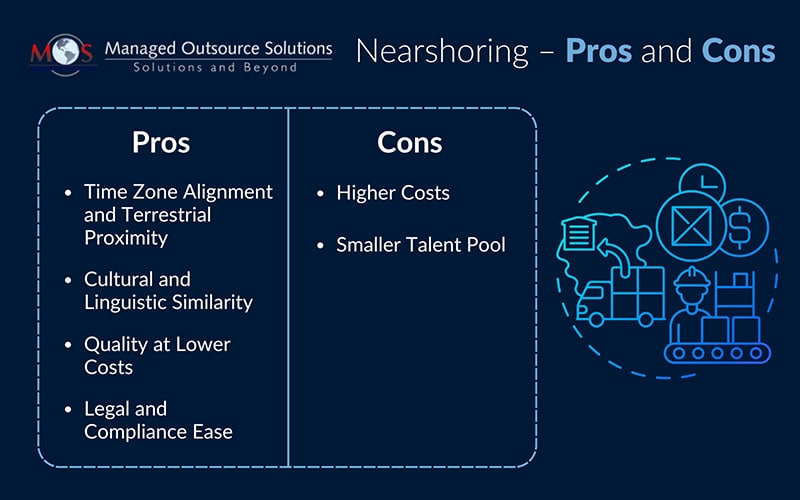In the present fast-paced global economy, outsourcing has grown into a strategic imperative for enterprises looking to optimize their operational costs and resources, while driving innovation. With outsourcing becoming a key strategy among companies worldwide, the most riveting question that needs an answer is: Should they choose nearshoring or offshoring?
A 2022 Global Outsourcing Survey by Deloitte revealed that around 70% companies prioritized outsourcing with a sole purpose in mind—to reduce costs. Even then, the problem lies in choosing the right model suited for their requirements.
This post will provide a clear insight into nearshoring and offshoring and compares their pros and cons. Collaborating with a leading provider of outsourcing services is the best way to choose the right option for your needs.
Nearshoring vs Offshoring
Outsourcing technically involves delegating specific business tasks to external providers, on a contract or regular basis. However, it is not that straightforward, as there are two models, depending upon the location of these service providers:
- Nearshoring: This model involves outsourcing work to a neighboring country, often within the same time zone or a similar economic region. For example: Japan may outsource parts of its business operations to nearby countries like Thailand or Indonesia.
- Offshoring: This involves collaborating with service providers in distant countries, operating out of different time zones and culture. For example, various companies in the U.S outsource their tasks to countries like India and the Philippines.
The Pros and Cons of Nearshoring
Advantages
- Time Zone Alignment and Terrestrial Proximity: One of the biggest advantages of nearshoring is the locational proximity and similar time zones. This enables flawless communication, improved collaboration and real-time feedback. This would be ideal for non-IT industries (automotive, manufacturing) where a lot of to-and-fro traveling might be required.
- Cultural and Linguistic Similarity: Nearshoring mitigates cultural and language barriers as often nearby countries would share cultures/language with each other. This enables a smoother work ethics and collaboration, thereby lowering miscommunications and improving overall productivity.
- Quality at Lower Costs: Nearshoring does not provide the supreme cost-savings of offshoring, but it strikes a sweet balance between affordability and quality. Companies will be able to tap a quality talent pool at competitive price points. Also, being closer, they would be able to closely monitor the team, thereby making them deliver high-quality work.
- Legal and Compliance Ease: Geopolitics play a crucial role in nearshoring as neighboring countries often have relaxed regulations and trade agreements, making it easier to navigate any legal business requirements. This makes the model a viable option for countries to outsource their work.
Disadvantages
- Higher Costs: Nearshoring is cost-effective but considerably more expensive than offshoring for businesses in the US. The wages in offshoring countries like India, Philippines, Thailand, etc. are significantly lower compared to nearshoring countries like Mexico or Honduras.
- Smaller Talent Pool: Offshoring destinations traditionally have a wider talent pool of niche skills required for the job, as opposed to nearshoring countries.
Nearshoring Example
Amazon outsources administrative work, software support, customer service, and engineering to Costa Rica. This has reduced delivery timelines and improved team communication due to the minimal time difference between the two nations.
The Pros and Cons of Offshoring
Advantages
- Significant Cost Savings: The major advantage of offshoring is its extremely affordable pricing. Asia, for example is a very competitive market, and many outsourcing companies are able to provide highly-skilled professionals at a bargain. Additionally, this presents companies an opportunity to expand into a new market without spending too much.
- Access to a Broader Talent Pool: Offshoring offers businesses unprecedented access into a large talent pool with specialized expertise across sectors like manufacturing, software development, customer care and IT.
- Better Scalability: Offshoring opens the door for enhanced scalability, as businesses can scale their teams/operations up or down, per given circumstances, due to the availability of skilled resources at lower costs.
- 24×7 Operations: Even though different time zones can cause issues regarding collaboration, it opens up another opportunity of “round the clock” service. Owing to the time difference, businesses can stay open beyond working hours, especially customer service, enhancing productivity and customer satisfaction.
Disadvantages
- Language/Cultural Roadblocks: Offshoring companies typically coming from different continents, can pose challenges related to cultural differences, language proficiency, and work ethics.
- Time Zone Differences: The big difference in time zones can create delays in real-time communication and completing tasks promptly. This will force the team to adopt flexible schedules like night shifts to compensate.
- Travel & Logistics Expenditure: Even though labor costs are low, frequent visits to the offshoring country for meetings/team management can stretch the budget further.
Offshoring Example
Microsoft outsources certain tasks like technical assistance, management of databases, and software applications to India. This has enabled them to reduce the workload and at the same time, save costs.
Choosing Between Nearshoring and Offshoring: Which One is Right For You?
Selecting the appropriate outsourcing model depends upon your business’ organizational priorities and long-term objectives.
- Cost vs. Quality: If you are prioritizing cost savings and confident that your business can adapt to language-cultural roadblocks, offshoring might be the right choice. However, quality and seamless collaboration is your priority, then nearshoring could provide a better value.
- Nature of Work: If your business has tasks requiring constant oversight and real-time collaboration, nearshoring will suit the best. But, if you are planning to outsource tasks that can be managed asynchronously, such as administrative operations, customer care etc., offshoring may be more suitable.
- Time Difference: Nearshoring reduces delays in delivery timeframes, making it ideal for projects with tight deadlines; Offshoring—while being significantly more affordable—may require constant adjustments in timelines and eventual deadlines.
- Skill Requirements: The first step required would be to pinpoint where the best talent for your needs are. If a nearby country offers the relevant skill set, nearshoring makes sense. For more niche or large-scale talent requirements, offshoring might be the ideal choice.
- Risk Tolerance: Regardless of whether you are opting for nearshoring or offshoring, it is important to evaluate potential risks within the country, such as political instability, economic volatility, or cultural indifferences, and figure out the ideal model to suit your requirements.
Why Not Both?
If you are a large organization with numerous operational departments, the ideal choice would be a hybrid model that blends nearshoring and offshoring. This way, your business can leverage the collaboration and productivity capabilities of nearshoring while utilizing offshoring for cost-driven tasks.
Choosing the Perfect Outsourcing Partner
Adopting the right outsourcing model can be challenging, but not choosing the right partner for it. With more than two decades of experience, Managed Outsource Solutions (MOS) is an outsourcing company specialized in delivering custom nearshoring or offshoring solutions, designed to meet businesses ever-evolving requirements.
Our result-driven approach and a wide network of high-quality teams ensure guaranteed results, at competitive costs. Whether you require nearshoring or offshoring support, our agile teams are ready to align with your operations.
Struggling to Choose Between Nearshoring and Offshoring?
We can help you to decide. Our experts will collaborate with to understand your business and guide you through choosing the right model to achieve your goals!






